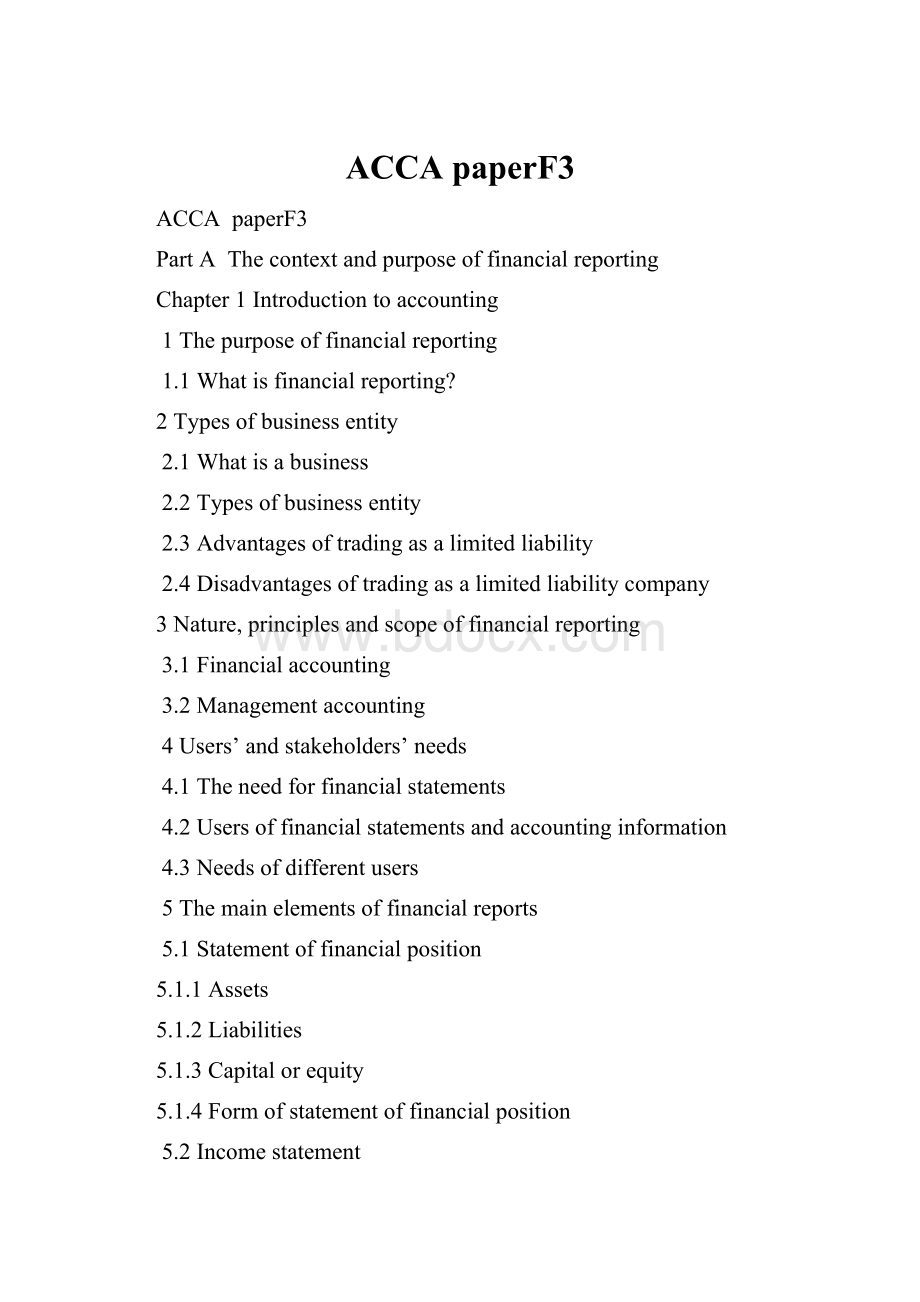ACCA paperF3.docx
《ACCA paperF3.docx》由会员分享,可在线阅读,更多相关《ACCA paperF3.docx(23页珍藏版)》请在冰豆网上搜索。

ACCApaperF3
ACCApaperF3
PartAThecontextandpurposeoffinancialreporting
Chapter1Introductiontoaccounting
1Thepurposeoffinancialreporting
1.1Whatisfinancialreporting?
2Typesofbusinessentity
2.1Whatisabusiness
2.2Typesofbusinessentity
2.3Advantagesoftradingasalimitedliability
2.4Disadvantagesoftradingasalimitedliabilitycompany
3Nature,principlesandscopeoffinancialreporting
3.1Financialaccounting
3.2Managementaccounting
4Users’andstakeholders’needs
4.1Theneedforfinancialstatements
4.2Usersoffinancialstatementsandaccountinginformation
4.3Needsofdifferentusers
5Themainelementsoffinancialreports
5.1Statementoffinancialposition
5.1.1Assets
5.1.2Liabilities
5.1.3Capitalorequity
5.1.4Formofstatementoffinancialposition
5.2Incomestatement
5.1.1Revenueandexpenses
5.1.2Formofincomestatement
5.3Purposeoffinancialstatements
Chapter2Theregulatoryframework
1Theregulatorysystem
1.1Introduction
1.2Nation/locallegislation
1.3Accountingconceptsandindividualjudgement
1.4Accountingstandards
1.4.1InternationalFinancialReportingStandardsandtheIASB
1.4.2StandardsAdvisoryCouncil(SAC)
1.4.3InternationalFinancialReportingInterpretationsCommittee(IFRIC)
1.4.4TheInternationalAccountingStandardsCommitteeFoundation(IASCF)
1.4.5TheuseandapplicationofIASsandIFRSs
1.4.6Benchmarkandallowedalternatives
1.5GenerallyAcceptedAccountingPractice(GAAP)
1.6Fairpresentation
1.6.1Fairpresentation‘override’
2TheInternationalAccountingStandardsBoard(IASB)
2.1Internationalharmonization
2.2CurrentpositionoftheIASB
3InternationalFinancialReportingStandards(IFRSs)andInternationalAccountingStandards(IASs)
3.1Standardsettingprocess
3.1.1CurrentIASs/IFRSs
3.2InterpretationofIASs/IFRSs---IFRIC
3.3ScopeandapplicationofIASsandIFRSs
3.3.1Scope
3.3.2Application
3.4WorldwideeffectofinternationalstandardsandIASB
3.5Accountingstandardsandchoice
PartBThequalitativecharacteristicsoffinancialinformationandthefundamentalbasesofaccounting
Chapter3Accountingconventions
1Background
2IAS1Presentationoffinancialstatements
2.1Objectivesandscope
2.2Purposeoffinancialstatements
2.3FairpresentationandcompliancewithIASs/IFRSs
2.4Accountingpolicies
2.5Goingconcern
2.6Example:
Goingconcern
2.7Accrualsbasisofaccounting
2.8Example:
Accrual
2.9Consistencyofpresentation
2.10Materialityandaggregation
2.11Offsetting
2.12Comparativeinformation
2.13Prudence
2.14Example:
Prudence
2.15Substanceoverform
2.16Presentationofaccountingpolicies
3TheIASB’sFramework
3.1Preface
3.2Introduction
3.2.1Purposeandstatus
3.2.2Scope
3.2.3Usersandtheirinformationneeds
3.3Theobjectiveoffinancialstatements
3.3.1Financialposition,performanceandchangesinfinancialposition
3.4Underlyingassumptions
3.5Qualitativecharacteristicsoffinancialstatements
3.6Understandability
3.7Relevance
3.8Reliability
3.9Faithfulrepresentation
3.10Substanceoverform
3.11Neutrality
3.12Prudence\
3.13Completeness
3.14Comparability
3.15Constraintsonrelevantandreliableinformation
3.15.1Timeliness
3.15.2Balancebetweenbenefitsandcost
3.15.3Balancebetweenqualitativecharacteristics
3.16Theelementsoffinancialstatements
3.17Recognitionoftheelementsoffinancialstatements
3.18Measurementoftheelementoffinancialstatements
3.19Conceptsofcapitalandcapitalmaintenance
4Criticismsofaccountingconventions
4.1Criticismsoftheprudenceconcept
4.2Criticismsoftheaccrualsassumption
5Basesofvaluation
5.1Historicalcost
5.2Replacementcost
5.3Netrealizablevalue
5.4Economicvalue
5.5Advantagesanddisadvantagesofhistoricalcostaccounting
5.5.1Non-currentassetvaluesareunrealistic
5.5.2Depreciationisinadequatetofinancethereplacementofnon-currentassets
5.5.3Holdinggainsoninventoriesareincludedinprofits
5.5.4Profits(orloss)onholdingofnetmonetaryitemsarenotshown
5.5.5Thetrueeffectofinflationoncapitalmaintenanceisnotshown
5.5.6Comparisonsovertimeareunrealistic
6IAS8Accountingpolicies,changesinaccountingestimatesanderrors
6.1Definitions
6.2Changesinaccountingpolicies
6.2.1AdoptionofanIFRS
6.2.2Otherchangesinaccountingpolicy:
PartCTheuseofdoubleentryandaccountingsystems
Chapter4Sources,recordsandbooksofprimeentry
1Theroleofsourcedocuments
1.1Typesofsourcedocuments
1.2Invoices
1.2.1Whatdoesaninvoiceshow?
1.2.2Usesofmulti-partinvoices
1.3Thecreditnote
1.4Otherdocuments
2Theneedforbooksofprimeentry
3Salesandpurchasedaybooks
3.1Thesalesdaybook
3.2Thepurchasedaybook
3.3Thesalesreturnsdaybook
3.4Thepurchasereturnsdaybook
4Cashbook
4.1Thecashbook
4.2Example:
Cashbook
4.3Bankstatements
5Pettycash
5.1Whatispettycash?
5.2Security
5.2.1Authorization
5.2.2Evidence
5.3Thepettycashbook
5.4Imprestsystem
5.5Example:
pettycashandtheimprestsystem
Chapter5Ledgeraccountsanddoubleentry
1Whydoweneedledgeraccounts?
2Thenominalledger
2.1Theformatofaledgeraccount
3Theaccountingequation
3.1Example:
Theaccountingequation
3.2Examplecontinued
3.3Profitintroducedintotheaccountingequation
3.4Drawings
3.5Examplecontinued
3.6Payablesandreceivables
3.6.1Tradeaccountspayableandtradeaccountsreceivable
3.6.2Examplecontinued
3.7Matching
4Doubleentrybookkeeping
4.1Dualeffect(dualityconcept)
4.2Therulesofdoubleentrybookkeeping
4.3Example:
Doubleentryforcashtransactions
4.4Credittransactions
4.5Example:
Credittransactions
4.5.1Whencashispaidtosuppliersorbycustomers
5Thejournal
5.1Examples:
Journalentries
5.2Thecorrectionoferrors
6Daybookanalysis
6.1Salesdaybook
6.2Salesreturnsdaybook
6.3Purchasedaybookandpurchasereturnsdaybook
6.3.1Purchases
6.3.2Purchasereturns
7Theimprestsystems
8Thereceivablesandpayablesledgers
8.1Impersonalaccountsandpersonalaccounts
8.2Thereceivablesledger
8.3Thepayablesledger
Chapter6Fromtrialbalancetofinancialstatements
1Thetrialbalance
1.1Thefirststep
1.2Balancingledgeraccounts
1.3Collectingthebalances
1.4Whatifthetrialbalanceshowsunequaldebitandcreditbalances?
1.5Example:
Trialbalance
2Theincomestatement
3Thestatementoffinancialposition
4Balancingaccountsandpreparingfinancialstatements
PartDRecordingtransactionsandevents
Chapter7Salestax
1Thenatureofsalestaxandhowitiscollected
1.1Howissalestaxlevied?
1.2Example
1.3Inputandoutputsalestax
1.4Irrecoverablesalestax
2Accountingforsalestax
2.1Incomestatement
2.2Salestaxinthecashbook,salesdaybookandpurchasedaybook
2.3Payableforsalestax
Chapter8Inventory
1Costofgoodssold
1.1Unsoldgoodsininventoryattheendofanaccountingperiod
1.2Example:
Closinginventory
1.3Examplecontinued
1.4Thecostofgoodssold
1.5Example:
Costofgoodssoldandvariationsininventorylevels
1.6Thecostofcarriageinwardsandoutwards
1.7Example:
Carriageinwardsandcarriageoutwards
1.8Goodswrittenofforwrittendown
1.9Example:
Inventorieswrittenoffandwrittendown
2Accountingforopeningandclosinginventories
2.1Recap
2.2Ledgeraccountingforinventories
3Countinginventories
4Valuinginventories
4.1Thebasicrule
4.2Applyingthebasicvaluationrule
4.3Determiningthepurchasecost
4.4FIFO(firstin,firstout)
4.5AVCO(averagecost)
4.6Inventoryvaluationsandprofit
4.7Example:
Inventoryvaluationsandprofit\
5IAS2Inventories
5.1Scope
5.2Definitions
5.3Measurementofinventories
5.4Costofinventories
5.4.1Costsofpurchase
5.4.2Costsofconversion
5.4.3Othercosts
5.4.4Techniquesformeasurementofcost
5.5Costformulas
5.6Netrealizablevalue(NRV)
5.7Recognitionasanexpense
Chapter9Tangiblenon-currentassets
1Capitalandrevenueexpenditure
1.1Capitalincomeandrevenueincome
1.2Capitaltransactions
1.3Whyisthedistinctionbetweencapitalandrevenueitemsimportant?
2Depreciationaccounting
2.1Depreciation
2.2Usefullife
2.3Residualvalue
2.4Depreciationmethods
2.5Disclosure
2.6Whatisdepreciation?
3Depreciation:
themechanics
3.1Methodsofdepreciation
3.2Thestraightlinemethod
3.3Example:
Straightlinedepreciation
3.4Assetsacquiredinthemiddleofanaccountingperiod
3.5Example:
Assetsacquiredinthemiddleofanaccountingperiod
3.6Thereducingbalancemethod
3.7Applyingadepreciationmethodconsistently
3.8Chargeinthemiddleofdepreciation
3.9Example:
Changeinmethodofdepreciation
3.10Afallinthevalueofanon-currentasset
3.11Example:
Fallinassetvalue
3.12Changeinexpectedusefullifeorresidualvalueofanasset
3.13Depreciationisnotacashexpense
3.14Accumulateddepreciation
3.15Example:
Depreciation
3.16Example:
Allowanceforthedepreciationwithassetsacquiredpart-waythroughtheyear
4Revaluationofnon-currentassets
4.1Example:
Therevaluationofnon-currentassets
4.2Accountingentries
4.3Depreciationonrevaluedassets
4.4Revaluationdownwards
5Non-currentassetdisposals
5.1Thedisposalofnon-currentassets
5.2Theprinciplesbehindcalculatingtheperiodorlossondisposal
5.3Example:
Disposalo